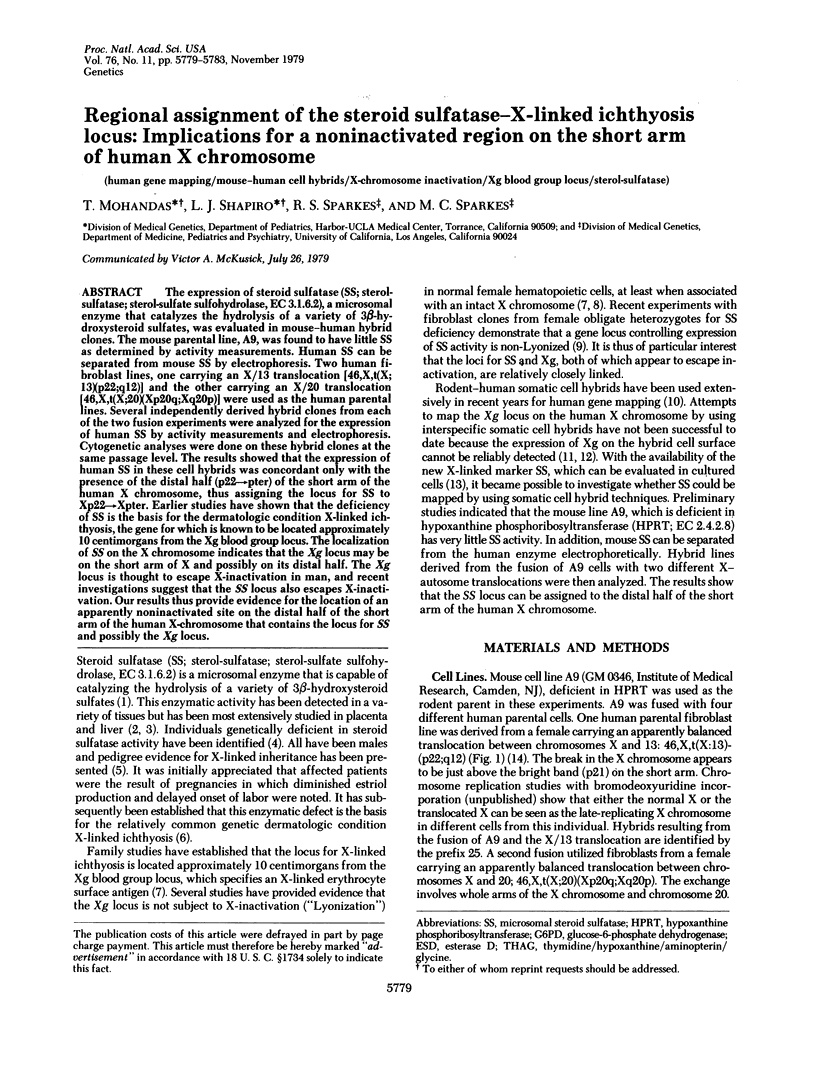Abstract
The expression of steroid sulfatase (SS; sterol-sulfatase; sterol-sulfate sulfohydrolase, EC 3.1.6.2), a microsomal enzyme that catalyzes the hydrolysis of a variety of 3β-hydroxysteroid sulfates, was evaluated in mouse—human hybrid clones. The mouse parental line, A9, was found to have little SS as determined by activity measurements. Human SS can be separated from mouse SS by electrophoresis. Two human fibroblast lines, one carrying an X/13 translocation [46,X,t(X;13)(p22;q12)] and the other carrying an X/20 translocation [46,X,t(X;20)(Xp20q;Xq20p)] were used as the human parental lines. Several independently derived hybrid clones from each of the two fusion experiments were analyzed for the expression of human SS by activity measurements and electrophoresis. Cytogenetic analyses were done on these hybrid clones at the same passage level. The results showed that the expression of human SS in these cell hybrids was concordant only with the presence of the distal half (p22→pter) of the short arm of the human X chromosome, thus assigning the locus for SS to Xp22→Xpter. Earlier studies have shown that the deficiency of SS is the basis for the dermatologic condition X-linked ichthyosis, the gene for which is known to be located approximately 10 centimorgans from the Xg blood group locus. The localization of SS on the X chromosome indicates that Xg locus may be on the short arm of X and possibly on its distal half. The Xg locus is thought to escape X-inactivation in man, and recent investigations suggest that the SS locus also escapes X-inactivation. Our results thus provide evidence for the location of an apparently noninactivated site on the distal half of the short arm of the human X-chromosome that contains the locus for SS and possibly the Xg locus.
Keywords: human gene mapping, mouse—human cell hybrids, X-chromosome inactivation, Xg blood group locus, sterol-sulfatase
Full text
PDF




Images in this article
Selected References
These references are in PubMed. This may not be the complete list of references from this article.
- Chen S., Creagan R. P., Nichols E. A., Ruddle F. H. Assigment of human esterase-D gene to chromosome 13. Cytogenet Cell Genet. 1975;14(3-6):269–272. doi: 10.1159/000130360. [DOI] [PubMed] [Google Scholar]
- Cross H. E., Hansen R. C., Morrow G., 3rd, Davis J. R. Retinoblastoma in a patient with a 13qXp translocation. Am J Ophthalmol. 1977 Oct;84(4):548–554. doi: 10.1016/0002-9394(77)90450-0. [DOI] [PubMed] [Google Scholar]
- Fellous M., Bengtsson B., Finnegan D., Bodmer W. F. Expression of the Xga antigen on cells in culture and its segregation in somatic cell hybrids. Ann Hum Genet. 1974 May;37(4):421–430. doi: 10.1111/j.1469-1809.1974.tb01847.x. [DOI] [PubMed] [Google Scholar]
- Fialkow P. J. X-chromosome inactivation and the Xg locus. Am J Hum Genet. 1970 Jul;22(4):460–463. [PMC free article] [PubMed] [Google Scholar]
- France J. T., Seddon R. J., Liggins G. C. A study of pregnancy with low estrogen production due to placental sulfatase deficiency. J Clin Endocrinol Metab. 1973 Jan;36(1):1–9. doi: 10.1210/jcem-36-1-1. [DOI] [PubMed] [Google Scholar]
- Gauthier R., Vigneault N., Bleau G., Chapdelaine A., Roberts K. D. Solubilization and partial purification of steroid sulfatase of human placenta. Steroids. 1978 Jun;31(6):783–798. doi: 10.1016/s0039-128x(78)80043-9. [DOI] [PubMed] [Google Scholar]
- Hopkinson D. A., Mestriner M. A., Cortner J., Harris H. Esterase D: a new human polymorphism. Ann Hum Genet. 1973 Oct;37(2):119–137. doi: 10.1111/j.1469-1809.1973.tb01820.x. [DOI] [PubMed] [Google Scholar]
- Hsu S. H., Migeon B. R., Bias W. B. Unreliability of the microcomplement fixation method for Xga typing of cultured fibroblasts. Birth Defects Orig Artic Ser. 1976;12(7):382–386. [PubMed] [Google Scholar]
- Iwamori M., Moser H. W., Kishimoto Y. Solubilization and partial purification of steroid sulfatase from rat liver: characterization of estrone sulfatase. Arch Biochem Biophys. 1976 May;174(1):199–208. doi: 10.1016/0003-9861(76)90339-8. [DOI] [PubMed] [Google Scholar]
- LINDSTEN J., FRACCARO M., POLANI P. E., HAMERTON J. L., SANGER R., RACE R. R. Evidence that the Xg blood group genes are on the short arm of the X chromosome. Nature. 1963 Feb 16;197:648–649. doi: 10.1038/197648a0. [DOI] [PubMed] [Google Scholar]
- LOWRY O. H., ROSEBROUGH N. J., FARR A. L., RANDALL R. J. Protein measurement with the Folin phenol reagent. J Biol Chem. 1951 Nov;193(1):265–275. [PubMed] [Google Scholar]
- LYON M. F. Gene action in the X-chromosome of the mouse (Mus musculus L.). Nature. 1961 Apr 22;190:372–373. doi: 10.1038/190372a0. [DOI] [PubMed] [Google Scholar]
- McKusick V. A., Ruddle F. H. The status of the gene map of the human chromosomes. Science. 1977 Apr 22;196(4288):390–405. doi: 10.1126/science.850784. [DOI] [PubMed] [Google Scholar]
- Mohandas T., Sparkes R. S., Sparkes M. C., Shulkin J. D. Assignment of the human gene for galactose-1-phosphate uridyltransferase to chromosome 9: studies with Chinese hamster-human somatic cell hybrids. Proc Natl Acad Sci U S A. 1977 Dec;74(12):5628–5631. doi: 10.1073/pnas.74.12.5628. [DOI] [PMC free article] [PubMed] [Google Scholar]
- Ruddle F. H., Creagan R. P. Parasexual approaches to the genetics of man. Annu Rev Genet. 1975;9:407–486. doi: 10.1146/annurev.ge.09.120175.002203. [DOI] [PubMed] [Google Scholar]
- Shapiro L. J., Cousins L., Fluharty A. L., Stevens R. L., Kihara H. Steroid sulfatase deficiency. Pediatr Res. 1977 Aug;11(8):894–897. doi: 10.1203/00006450-197708000-00008. [DOI] [PubMed] [Google Scholar]
- Shapiro L. J., Mohandas T., Weiss R., Romeo G. Non-inactivation of an x-chromosome locus in man. Science. 1979 Jun 15;204(4398):1224–1226. doi: 10.1126/science.156396. [DOI] [PubMed] [Google Scholar]
- Shapiro L. J., Weiss R., Buxman M. M., Vidgoff J., Dimond R. L., Roller J. A., Wells R. S. Enzymatic basis of typical X-linked icthyosis. Lancet. 1978 Oct 7;2(8093):756–757. doi: 10.1016/s0140-6736(78)92646-6. [DOI] [PubMed] [Google Scholar]
- Sparkes R. S., Baluda M. C., Townsend D. E. Cellulose acetate electrophoresis of human glucose-6-phosphate dehydrogenase. J Lab Clin Med. 1969 Mar;73(3):531–534. [PubMed] [Google Scholar]
- Therman E., Sarto G. E., Distèche C., Denniston C. A possible active segment on the inactive human X chromosome. Chromosoma. 1976 Dec 16;59(2):137–145. doi: 10.1007/BF00328482. [DOI] [PubMed] [Google Scholar]
- Webster D., France J. T., Shapiro L. J., Weiss R. X-linked ichthyosis due to steroid-sulphatase deficiency. Lancet. 1978 Jan 14;1(8055):70–72. doi: 10.1016/s0140-6736(78)90005-3. [DOI] [PubMed] [Google Scholar]




